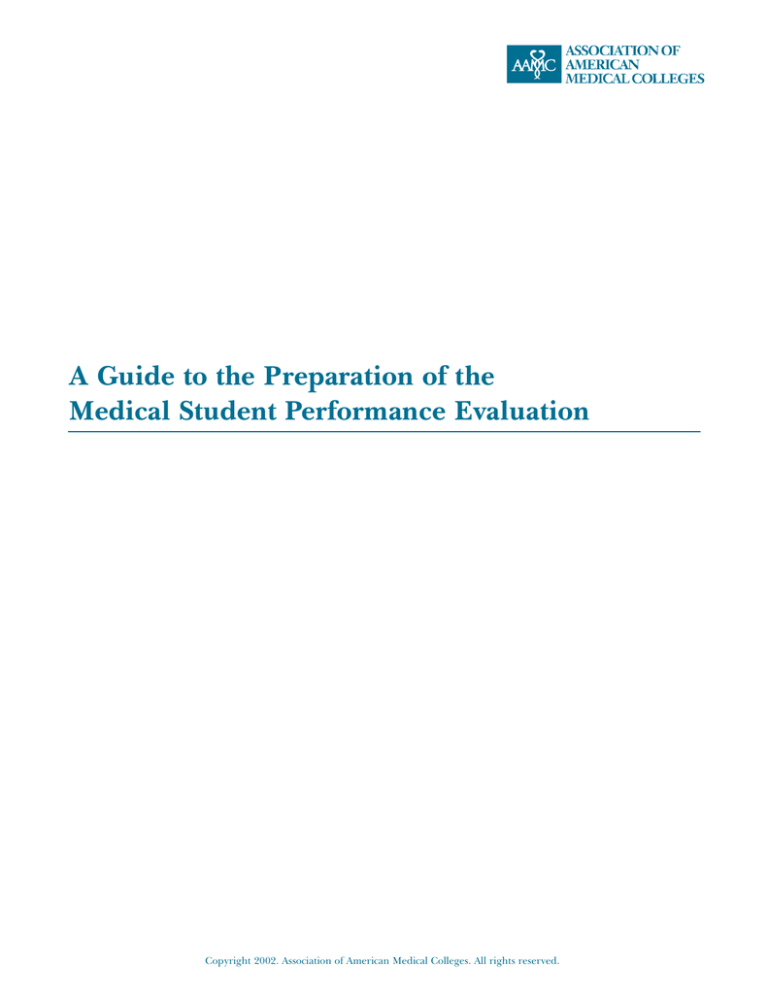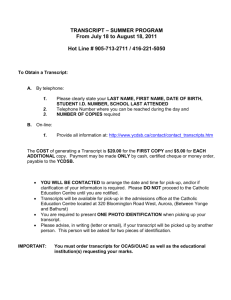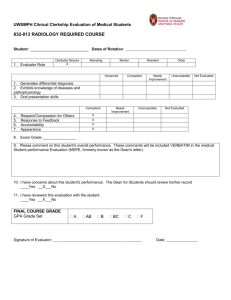
A Guide to the Preparation of the
Medical Student Performance Evaluation
Copyright 2002. Association of American Medical Colleges. All rights reserved.
Foreword
tify faculty members who will advocate their
suitability for a career in a specialty and to
write a separate letter of recommendation for their
training in that specialty.”
Establishment of Initial Guidelines for the
Dean’s Letter
In 1989, the Association of American Medical
Colleges (AAMC) charged a Committee on Deans’
Letters, composed of experienced representatives
from medical schools and graduate medical education (GME) programs, to “develop guidelines on
the evaluative information desired by program
directors” and to “explore the feasibility of providing a model format for deans’ letters.” In 1989,
the AAMC distributed the resulting “Guide to the
Preparation of the Medical School Dean’s Letter,”
in which the committee noted that:
■
“Graduation from medical school…is the student’s
transition from a general phase to a specialized
phase” of medical education.
■
“Residency program directors and their selection
committees require information about the levels
of accomplishment candidates for their programs
have achieved during medical school. The
transmission of this information is through an
instrument termed THE DEAN’S LETTER of
EVALUATION.”
■
■
■
■
The dean’s letter “is not a letter of recommendation; it is a letter of evaluation.”
A “common, recurrent complaint of those who
interpret deans’ letters of evaluation is that too
often it is impossible to estimate how a candidate
performed in comparison to his or her peers.
The dean’s letter can provide information about
comparative performance. The comparative
report should be compiled and formatted so that
a recipient can perceive a candidate’s performance profile consistent with the medical school’s
grading system.”
The “gradations [within medical school grading
systems] are sufficient to place a candidate’s
performance in relationship to his or her classmates. These descriptions of performance can be
included in the body of the letter, but a more
easily interpreted display is recommended.”
“Rarely do those who prepare dean’s letters of
evaluation have sufficient information to be students’ advocates for selection in a particular
specialty. Students should be counseled to iden-
A Need for Revision, Enhancement, and
Continuous Quality Improvement
In late 2000, four factors resulted in the AAMC’s
appointment of a second Dean’s Letter Advisory
Committee (DLAC):
■
A lack of implementation by all schools of the
1989 guidelines.
■
The involvement, by a variety of professional
organizations, in significant ongoing efforts to
define and assess professionalism in medicine.
■
The decline in the importance of the dean’s
letter to the GME community.
■
The significant changes in the delivery of residency application information resulting from
the introduction of the Electronic Residency
Application Service (ERAS).
During 2001-02, the DLAC:
■
Consulted with the medical school and GME
communities through a comprehensive Webbased questionnaire.
■
Developed a comprehensive set of preliminary
recommendations and presented them at the
2001 AAMC Annual Meeting.
■
Received and incorporated feedback regarding
these preliminary recommendations from the
medical school and GME communities.
■
Submitted a comprehensive set of final recommendations to the AAMC Executive Council.
The final recommendations of the DLAC,
approved by the AAMC Executive Council in
March 2002, represent attempts to:
■
Ensure consistency in the re-designed and renamed Medical Student Performance Evaluation
across medical schools.
■
Strongly reaffirm the purpose of the Medical
Student Performance Evaluation.
Copyright 2002. Association of American Medical Colleges. All rights reserved.
1
■
Improve collaboration and communication
between senders and recipients of the Medical
Student Performance Evaluation.
■
Establish an ongoing quality improvement
process, across medical schools, for the Medical
Student Performance Evaluation.
The Medical Student Performance
Evaluation
Name and Purpose. The name of the dean’s letter
has been changed, effective immediately, to Medical
Student Performance Evaluation (MSPE) in order
to reflect its purpose as an evaluation of a medical
student’s performance (rather than a recommendation or prediction of future performance). The
MSPE describes, in a sequential manner, a student’s
performance, as compared to that of his/her peers,
through three full years of medical school and, as
much as possible, the fourth year. The MSPE
includes an assessment of both the student’s academic performance and professional attributes.
Timeline. The MSPE is completed upon the successful completion of all core clinical clerkships
(Family Medicine, Internal Medicine, Obstetrics
and Gynecology, Pediatrics, Psychiatry, and Surgery)
in the third year (or their institutional equivalents).
Composition. Final authority for composing the
MSPE, as an institutional assessment composed on
behalf of the medical school faculty, should rest with
a professional person, at the faculty level in the
institution, who has access to all relevant evaluation
data for all students. Ideally, the process by which
the MSPE is composed should include a personal
meeting with each student.
ERAS Post Office opening date. With the
approval of the Electronic Residency Application
Service (ERAS) Advisory Committee, the opening
date of the ERAS Post Office has been moved, by
two weeks, from August 15 to September 1.
NRMP Rank Order List deadline date. With the
approval of the National Resident Matching
Program (NRMP) Board of Directors, the deadline date for submission of Rank Order Lists
(ROL) for the Main Match has been moved later
by six days.
Mode of delivery. The MSPE will be delivered via
ERAS in a computer file compatible with an
Internet-based delivery system.
MSPE Advisory Committee. An MSPE Advisory
Committee has been established to:
■
Establish a mechanism for ongoing information
exchange between schools and GME programs
about the MSPE.
■
Implement recommendations for standardization
of MSPE content and format among medical
schools.
■
Define a standard set of measurable professional
attributes expected of medical students.
■
Develop by 2006, in concert with a representative group of medical schools, policy and procedure guidelines for the systematic, performancebased assessment, across third-year clerkships,
of these professional attributes. This assessment
will be a component of the academic evaluation
of students and complementary to the grade
that will appear on the academic transcript.
■
Ensure a continuous quality improvement
process for the MSPE.
Student review. The MSPE, as an institutional
assessment, should be considered a component of
the student’s academic record and, thus, be available for a student’s review. The student should be
permitted to correct factual errors in the MSPE,
but not to revise evaluative statements in the MSPE.
Release date. The MSPE release date will continue
to be November 1.
2
Copyright 2002. Association of American Medical Colleges. All rights reserved.
A Guide to the Preparation of the
Medical Student Performance
Evaluation
Length and Format: The MSPE should be a twoto-three page, single-spaced, appropriately formatted document, with five appendices. The MSPE
should be typed, single-spaced, in New Times
Roman, 12-point font with a one-inch margin on
each side.
The Academic Progress section includes information about the student’s academic performance
and professional attributes in preclinical/basic science coursework and core clinical and elective
rotations, as follows:
■
Narrative information regarding the student’s
overall (rather than course-specific) performance in the preclinical/basic science curriculum.
■
Narrative information regarding the student’s
overall performance on each core clinical clerkship and elective rotation completed to date, with
a focus on summative, rather than formative,
comments by clerkship/elective directors. This
information should be provided in the chronological order in which the student completed
each core clinical clerkship and elective rotation.
Information should be provided about the location of any “away” elective rotations.
■
Narrative information about the student’s level
of initiative, enthusiasm, and ability to self-start
in all curricular components.
■
An assessment of the student’s compatibility
with faculty members, peers, other members of
the health care team, and patients during all
curricular components.
Content: The MSPE contains six sections:
The Identifying Information section includes the:
■
Student’s legal name.
■
Name and location of the medical school.
The Unique Characteristics section includes a
brief statement about the unique characteristics of
the student, as follows:
■
■
Information about special considerations,
including any distinguishing characteristics
exhibited by the student in medical school (e.g.,
demonstrated leadership and research abilities,
participation in community service activities).
Information about any significant challenges or
hardships encountered by the student during
medical school.
The Academic History section includes:
■
The month and year of the student’s initial
matriculation in, and expected graduation
from, medical school.
■
An explanation, based on school-specific policies,
of any extensions, leave(s) of absence, gap(s), or
break(s) in the student’s educational program.
■
Information about the student’s prior, current,
or expected enrollment in, and the month and
year of the student’s expected graduation from,
dual, joint, or combined degree programs.
■
Information, based upon school-specific policies,
of coursework that the student was required to
repeat or otherwise remediate during the student’s medical education.
■
Information, based on school-specific policies, of
any adverse action(s) imposed on the student
by the medical school or its parent institution.
The Summary section includes a summative
assessment, based upon the school’s evaluation
system, of the student’s comparative performance
in medical school, relative to his/her peers, including information about any school-specific categories used in differentiating among levels of student performance.
The Appendices section includes:
■
Appendix A: a graphic representation of the
student’s performance, relative to his/her peers,
in each preclinical/basic science course.
■
Appendix B: a graphic representation of the
student’s performance, relative to his/her peers,
in each core third-year clinical clerkship.
■
Appendix C: information supplementary to that
contained in the body of the MSPE regarding
the assessment of the student’s performance,
relative to his/her peers, in the area of professional attributes. This assessment should be
linked to those professional attributes of students
that are specifically and systematically observed,
Copyright 2002. Association of American Medical Colleges. All rights reserved.
3
4
evaluated and reported upon by medical school
faculty members. Where the medical school has
defined a set of professional attributes for which
systematic evaluations are available, a graphic
representation of the student’s comparative
performance in this area is recommended. Where
the medical school has not yet defined and/or
does not systematically evaluate a set of essential
professional attributes, a narrative assessment, in
the body of the MSPE, of the degree to which
the student has demonstrated the following
professional attributes, relative to his/her peers,
should be considered: ability to treat patients
with compassion; honesty and integrity; respect
for others; ability to act as an advocate for
patients; communication skills; and commitment
to putting the needs of others before one’s own
needs. A final set of recommendations for this
appendix is expected by 2006.
■
A description of the evaluation system used at
the medical school, including a “translation” of
the “meaning” of the grades received by the
student.
■
A statement about medical school requirements
regarding a student’s successful completion of
USMLE Step 1 and Step 2 for promotion
and/or graduation.
■
Information about the use at the medical school
of Objective Structured Clinical Evaluations
(OSCEs) in the assessment of medical students.
■
Information about the utilization of narrative
comments from medical school course, clerkship,
or elective directors in the composition of the
MSPE.
■
Information about the process by which the
MSPE is composed at the medical school
■
Appendix D: a graphic representation of the
student’s overall performance in medical school,
relative to his/her peers, including a list of the
school-specific categories used in distinguishing
among levels of student performance, a definition of each category, and a report of the distribution of students among categories.
■
Information about whether the student is permitted to review his/her MSPE prior to transmission.
■
Appendix E: the Medical School Information
Page, includes:
■
Information about any specific programmatic
emphases, strengths, mission(s), or goal(s) of
the medical school.
■
Information about any unusual characteristics
of the medical school’s educational program,
including the timing of preclinical/ basic science
coursework, core clinical clerkships, and elective
rotations.
■
Information about the average length of enrollment of students in this graduating class, from
initial matriculation until graduation.
■
Information about the medical school’s compliance with the AAMC “Guidelines for Medical
Schools Regarding Academic Transcripts”
(www.aamc.org/members/gsa/transcripts.htm
and see page 9).
Copyright 2002. Association of American Medical Colleges. All rights reserved.
Template
Medical Student Performance Evaluation
for
Student’s Legal Name
Month, Date, Year
Identifying Information
is a fourth-year student at
Student’s Legal Name
in
Medical School
.
City, State
Unique Characteristics
(Provide narrative information about distinguishing characteristics exhibited and any significant challenges or hardships encountered by the student during medical school)
Academic History
Date of Expected Graduation from Medical School:
Date of Initial Matriculation in Medical School:
Month, Date, Year
Month, Date, Year
Please explain any extensions, leave(s) of absence, gap(s),
or break(s)in the student’s educational program.
For transfer students:
Date of Initial Matriculation in Prior Medical School:
Date of Transfer from Prior Medical School:
or
❏ Not applicable
❏ Not applicable
Month, Date, Year
Month, Date, Year
For dual/joint/combined degree students:
Date of Initial Matriculation in Other Degree Program:
Date of Expected Graduation from Other Degree Program:
Type of Other Degree Program:
❏ Not applicable
Month, Date, Year
Month, Date, Year
Degree, Major
Was this student required to repeat or otherwise
remediate any coursework during his/her
medical education?
❏ No
❏ Yes - Please explain:
Was this student the recipient of any adverse actions(s)
by the medical school or its parent institution?
❏ No
❏ Yes - Please explain:
Copyright 2002. Association of American Medical Colleges. All rights reserved.
5
Academic Progress
Preclinical/Basic Science Curriculum:
(Provide narrative information about overall, not course-specific, performance)
Core Clinical Clerkships and Elective Rotations:
(Provide a narrative evaluation about each core clinical clerkship and elective rotation taken in chronological order)
Example I
Example II:
(when school policy requires that students complete all
core clerkships prior to enrollment in electives)
(when school policy permits interspersal of core clerkships and
electives)
Clerkship 1:
Clerkship 1:
Clerkship 2:
Clerkship 2:
Clerkship 3:
Elective 1:
(Provide location if an “away” elective rotation)
Clerkship 4:
Clerkship 3:
Clerkship 5:
Clerkship 4:
Clerkship 6:
Elective 2:
(Provide location if an “away” elective rotation)
Elective 1:
Clerkship 5:
(Provide location if an “away” elective rotation)
Elective 2:
Clerkship 6:
(Provide location if an “away” elective rotation)
Summary
(Provide a summative assessment, in narrative format, of the student’s comparative performance, relative to his/her peers, in medical school, including information about any school-specific categories used in differentiating among levels of student performance)
Signature of School Official
Name of School Official
Title
E-mail address
6
Copyright 2002. Association of American Medical Colleges. All rights reserved.
For purposes of illustration only; school-specific course and clerkship names, grading systems, and categories
of overall performance will vary by school.
Appendix A
Graphic Representations of Comparative Performance
in Preclinical/Basic Science Coursework
50
40
A
B
C
D
F
30
% of Class
20
10
0
Gross
Anatomy
Physiology Biochemistry
Histology Neuroanatomy
ICM I
ICM II
First-Year Courses
Appendix B
Graphic Representations of Comparative Performance
in Core Clinical Clerkships
70
60
50
High Honors
Honors
Pass
Low Pass
Fail
40
% of Class
30
20
10
0
Family
Medicine
Internal
Medicine
Psychiatry
Ob/Gyn
Pediatrics
Surgery
Clerkships
Appendix C
60
Graphic Representations of Comparative Performance
in Professional Attributes
50
(Final recommendations expected by 2006)
40
of Students
Exemplary
Adequate
Below Average
30
20
10
0
Treats
Patients
Compassio
Honest/Has
Integrity
Ability to
Communicate
Respects
Others
Advocates
for
Patients
Puts Others
Needs
First
Attributes
Appendix D
Graphic Representations of Overall Comparative Performance in Medical School
18
45
16
40
14
35
12
# of Students
Students
10
30
25
8
# of Students
in Category 20
6
15
4
10
2
5
0
First Quartile
(1-24 percentile)
Second Quartile
(25-49 percentile)
Third Quartile
(50-74 percentile)
Fourth Quartile
(75-100 percentile)
0
Students
Below Average
Average
Above Average
With Distinction
Level of Performance
Copyright 2002. Association of American Medical Colleges. All rights reserved.
7
Appendix E
Medical School Information Page
Medical School Name
City, State
Special programmatic emphases, strengths, mission/goal(s) of the medical school:
Special characteristics of the medical school’s educational program:
Average length of enrollment (initial matriculation to graduation) at the medical school:
Years
Months
Description of the evaluation system used at the medical school:
Medical school requirements for successful completion of USMLE Step 1, 2 (check all that apply):
USMLE Step 1:
USMLE Step 2:
❏ Required for promotion
❏ Required for promotion
❏ Required for graduation
❏ Required for graduation
❏ Required, but not for promotion/graduation ❏ Required, but not for promotion/graduation
❏ Not required
❏ Not required
Medical school requirements for successful completion of Objective/Observed Structured Clinical
Evaluation (OSCE) at medical school. OSCEs are used for (check all that apply):
❏ Completion of course
❏ Completion of clerkship
❏ Completion of third year
❏ Graduation
❏ Other:
Utilization of the course, clerkship, or elective director’s narrative comments in composition of the MSPE.
The narrative comments contained in the attached MSPE can best be described as (check one):
❏ Reported exactly as written
❏ Edited for length or grammar, but not for content
❏ Edited for content or included selectively
Utilization by the medical school of the AAMC “Guidelines for Medical Schools Regarding Academic
Transcripts.” This medical school is:
❏ Completely in compliance with Guidelines’ recommendations
❏ Partially in compliance with Guidelines’ recommendations
Exceptions:
❏ Not in compliance with Guidelines’ recommendations
Description of the process by which the MSPE is composed at the medical school (including number of
school personnel involved in composition of the MSPE).
Students are permitted to review the MSPE prior to its transmission:
❏ Yes
❏ No
8
Copyright 2002. Association of American Medical Colleges. All rights reserved.
Group on Student Affairs Guidelines for Medical Schools
Regarding Academic Transcripts
An academic transcript is a certified document intended for use by parties outside the educational institution
and is an unabridged summary of the student's academic history at that institution. It is distinguished from
the larger body of information which may be contained in the student's educational or academic record.
The educational or academic record is an internal document that also reflects the student's unabridged
academic history at the institution, but which may contain additional data that are useful internally, yet not
needed externally.
1. Medical schools are encouraged to follow the recommendations of the American Association of
Collegiate Registrars and Admissions Officers (AACRAO) as published in the Academic Record and
Transcript Guide. Where the medical school is part of a university, the school is encouraged to consult
with the university registrar to ensure that the medical school transcript is in compliance with
university requirements.
2. The academic transcript should reflect the total, unabridged academic history of the student at the
institution. All courses should be recorded in the academic period in which the course was taken and
graded.
3. Essential elements of an academic transcript include: name of institution, location of institution, name
of student, terms of attendance, withdrawal date, course identification number and title, credit hours
for each course, units of credit, grade in each course, summary of transfer credit accepted and the
name of the institution from which the credit is accepted, any instances of academic suspension or
dismissal and the date, title of degree awarded, date degree is conferred, program studied (i.e., medicine),
date of issuance of the transcript, and date of last entry to the transcript. Name changes should be
recorded on transcripts only while the individual is enrolled and the name can be changed concurrently
in the AAMC database.
4. Each student should have a unique identification number that is recorded on the transcript.
5. The following items are NOT recommended for inclusion on the academic transcript (although the
institution may wish to retain some of these items in the educational or academic record): student's
address, place of birth, gender, ethnicity, marital status, religious preference, disability, and INS status;
secondary school data; prior post-secondary school data; academic probation; class rank.
6. Medical schools should record on a transcript only that academic information which is under the
purview of the school's faculty of medicine. Consequently, United States Medical Licensing Examination
(USMLE) results and election to Alpha Omega Alpha (AOA) should NOT be included on the transcript.
However, honors awarded by the school's faculty, either in course or at graduation, should be included
on the transcript.
7. It is essential that the transcript include notation of any academic suspension or dismissal since this is
an academic action that interrupts the student's continued enrollment. Similarly, a suspension for
academic misconduct (e.g., plagiarism) should be included on the transcript. While an institution may
want to include academic probation in the educational database, it is not desirable to include this status
on an academic transcript since the definition of academic probation varies from school to school.
Thus, the item serves no useful purpose on an academic transcript which, by definition, is intended
for use outside the school. In any event, if academic probation is included on the transcript, it is vital
that this term be clearly defined in the transcript legend or key.
Copyright 2002. Association of American Medical Colleges. All rights reserved.
9
8. Where a student is dismissed, the transcript should record the initial date of dismissal. If there is a
subsequent appeal, the result of this appeal and the date of this decision should be recorded, as well.
If the student is permitted to continue in the curriculum pending the outcome of an appeal, this
should be noted on the transcript with a footnote.
9. In the case of a student who is a candidate for two degrees (e.g., MD/PhD), courses which are given
combined or dual credit toward both degrees should be so noted.
10. The transcript should include the title and number for each course taken by the student and should
show the academic period in which the course is taken. Both required and elective courses should be
courses that have been developed and approved by faculty following the school's procedures for
approval of courses. All courses, including elective courses, should have an identification number,
title, and course description and appear in the school's Bulletin or Elective Handbook, or both. In
the case when a student is currently enrolled, courses which the student is taking are listed with an
indication that these courses are in progress.
11. The transcript should include a legend that explains the grading system, symbols, inclusive dates for
grading systems where changes have occurred, honors, units of credit, and notation of courses in
progress. If the school requires a passing score on USMLE for promotion and/or graduation, this
policy should be included in the transcript legend. Additionally, the legend should include the
accreditation status of the school, Family Educational Rights and Privacy Act (FERPA) disclaimer, and
an explanation of how the authenticity of the transcript can be determined.
12. Issuing official academic transcripts is a central and unique function of the Registrar's Office. Transcripts
should be issued only upon written request of the student/alumnus who has properly identified himself/herself with an ID card, driver's license, or signature on a request form or letter. Telephone and
e-mail requests for transcripts should NOT be accepted because security and authenticity cannot be
ensured.
a. A transcript is issued only at the written request of the student/alumnus or a specified third party
whom the student/alumnus has authorized, in writing, to obtain a transcript for a specific stated
purpose. The request must be signed and dated; the third party must be specified and the release
must state that the school may release the student's/alumnus' transcript for that purpose.
b. A transcript ceases to be an "official" transcript if it is photocopied or faxed. An original transcript
must not be transferred to a third party since doing so violates FERPA.
c. The Registrar's Office must maintain a Transcript Transmittal Record for each student/alumnus.
This record must show the date and party to whom a transcript is sent and the purpose for which
the transcript is issued. Transcripts issued to the student/alumnus should say "Issued to the
Student" rather than "Unofficial Transcript" since the latter can be altered easily.
d. If the school has a policy that requires withholding transcripts for default on student loans or other
reasons, that policy should be stated clearly in both the Bulletin and the Student Handbook. Transcript
holds for financial reasons should be limited to charges that relate directly to the education that is
reported on the student's/alumnus' academic transcript.
e. If there is an institutional charge for issuing a transcript, this fee should be modest.
10
Copyright 2002. Association of American Medical Colleges. All rights reserved.
f. Faxing a transcript should be avoided unless there is an urgency that requires immediate transfer.
If a transcript is faxed, it is important that proper procedures for the transcript request be used
(#12.a.); a properly signed fax request may be accepted. Additionally, a transcript that is faxed
should be considered "unofficial" and used only until an original can be sent. A cover memorandum
should describe the document as confidential information intended for the exclusive use of the
addressee.
13. Where a transcript is to be transmitted electronically (e.g., ERAS, SPEEDE), it is recommended that
the system used require that the sending and receiving stations be authenticated.
14. Schools are encouraged to take a number of steps to protect the institution from fraudulent transcripts.
The use of special paper, multicolored pens for the Registrar's signature, metered postage rather
than postage stamps and inclusion of a physical description of the transcript in the transcript key are
helpful ways to improve security. Additionally, it is recommended that the transcript include an institutional statement regarding the school's plans to pursue vigorously all allegations of security breaches
with respect to transcripts.
15. The educational record database and academic transcripts should be stored in a secure location
which is fireproof. Access to the database and to the area where documents and equipment (records,
stationery, and the school seal and signature equipment) are stored should be limited to authorized
personnel only.
16. A medical school should have a disaster plan for the secure storage and recovery of educational records
and academic transcripts which may be damaged or destroyed in the event of a catastrophic disaster.
Usually, this entails the identification of a remote location where duplicate records are maintained. It
is important for the school to develop an appropriate protocol for the regular duplication and transfer
of records to the remote location.
Copyright 2002. Association of American Medical Colleges. All rights reserved.
11
Dean’s Letter Advisory Committee
Robert C. Talley, M.D., Chair
Vice President for Health Affairs and Dean
University of South Dakota School of Medicine
Sioux Falls, SD
David Brett-Major
Student
Uniformed Services University
of the Health Sciences
F. Edward Hébert School of Medicine
Bethesda, MD
Dwight Davis, M.D.
Associate Dean for Admissions
and Student Affairs
Pennsylvania State University
College of Medicine
Hershey, PA
John Herman, M.D.
Clinical Director
Department of Psychiatry
Massachusetts General Hospital/
McLean Hospital
Boston, MA
Carol E. MacLaren, Ph.D.
Assistant Dean, Student Affairs
University of Washington
School of Medicine
Seattle, WA
Robert J. Nolan, Jr., M.D.
Deputy Chair for Education and Training
Department of Pediatrics
University of Texas Medical School
at San Antonio
San Antonio, TX
Eric L. Radin, M.D.
Professor, Orthopaedic Surgery
Tufts University
School of Medicine
Boston, MA
Ajit K. Sachdeva, M.D.
Director, Division of Education
American College of Surgeons
Chicago, Illinois
Susan Skochelak, M.D., M.P.H.
Senior Associate Dean for Academic Affairs
University of Wisconsin Medical School
Madison, WI
Lisa Wallenstein, M.D.
Association of Program Directors
in Internal Medicine
Washington, DC
Copyright 2002. Association of American Medical Colleges. All rights reserved.




